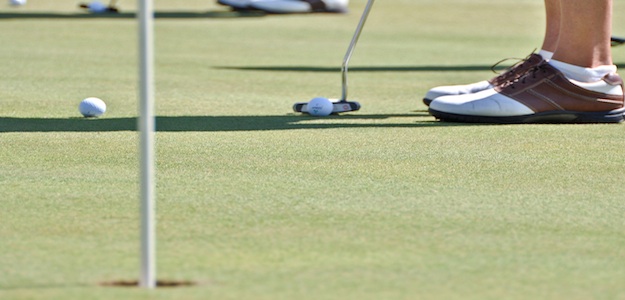I spent four hours on the golf course yesterday with my son Mitch. He’s a funny guy (I told a story about him in yesterday’s post) and becoming a pretty good golfer.
Golf, like most sports, teaches principles that can be applied to other areas of life as well. You don’t have to be an avid golfer to learn and appreciate these principles. Personally, the little white ball is always teaching me how to deal with failure. As one golf pro told me, I’m much too close to my ball after I hit it.
In this post, I want to focus on three steps I take on the putting green which relate to decision-making. Putting is an art form. It’s all about making a good decision and then executing well on that decision.
When I work through each of these steps, it puts me in the best position to make the putt. And even if I don’t make the putt (which often happens) I am hopefully closer to my goal with better odds of making the next one.
1. Line it up
Every green is different. Every spot on the green offers a different path to reach the cup. I will look at the potential path from behind the ball. I’ll walk around and look at the potential path from behind the cup. In fact, I won’t truly know what the potential path might be until I’ve taken the time to look at what the short green grass tells me between my ball and the cup.
Making a good decision takes information. It takes the ability to look ahead at your goal or desired outcome and see what lies ahead. You have to be able to see the potential turns and obstacles you’ll face.
Decisions create direction. Just like the cup on a putting green, you make decisions based on a target. Without this target, you can hit the ball haphazardly and let it roll wherever it wants. But the moment you want to achieve something, the moment you have a goal, the consequences of your decision take on meaning and significance.
All too often, I’ll putt my ball right at the cup without taking into consideration the lay of the land. Then I’m surprised when my ball rolls twenty feet away from the cup because I didn’t correctly analyze the slope of the green.
Making a decision in the moment without considering the potential consequences can often leave us farther away from where we hoped to end up.
2. Check your speed.
With every putt, I have to discern: how hard do I hit it? Speed will dictate how the ball travels over the potential path.
I know that my ball will have more momentum after it is struck by the putter. That will take some of the initial bumps in the road out of the equation. The speed of the ball will keep it on track.
This is true with so many decisions we make. The initial momentum we feel may help us to overcome certain obstacles and difficulties that would move us off course. But momentum is difficult to maintain. Hopefully, our initial efforts can sustain us on the path that leads us closer to our desired outcome.
Speed is the result of execution. The ball will go as fast as I hit it. Even if I have a desired speed in my mind, it doesn’t always translate to that speed when my putter strikes the ball. Putting takes practice. Making good decisions takes practice as well. Some decisions require a lot of time to make. Some must be made quickly.
Timing is crucial to good decision-making. Even if you’re headed in the right direction, poor timing can throw everything off.
3. Get it close.
My first goal with every putt is for it to go in the hole. But that’s not realistic. So I have a second goal in my mind: get this ball as close to the cup as possible so if I miss, my next putt is an easy one.
Every decision we make falls on the heels of previous decisions. A person’s character is formed by the small decisions, both public and private, he or she makes every day. Those decisions create momentum in a certain direction over time.
When my ball hits the green, I want to only putt twice at the most. Putting once on each green would be great! But if I miss that first putt, I want to make sure I’m close to the hole for the next putt. And when I say close, I’m talking about just past the cup. It’s not good practice to leave your putt short. Short putts never go in.
The same risk is evident in our decisions. Some decisions keep us moving in the right direction, but they don’t give us any chance of reaching our desired outcome. We end up being short of our goal.
I would encourage you to pick up your putter and a few golf balls and spend some time on the practice green at your local golf course. As you line up each putt, check your speed, and attempt to get it close, consider the other decisions in your life with these principles in mind.
What other lessons have you learned on the golf course? I’d love for you to share them with us in the comments below.
Share this Post

